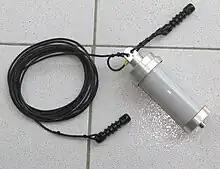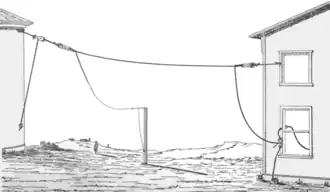
A random wire antenna is a radio antenna consisting of a long wire suspended above the ground, whose length does not bear a particular relation to the wavelength of the radio waves used, but is typically chosen more for convenient fit between the available supports, or the length of wire at hand, rather than selecting length to be resonant on any particular frequency. The wire may be straight or it may be strung back and forth between trees or walls just to get enough wire into the air. Due to the great variability of the (unplanned) antenna structure, effectiveness can vary widely from one installation to another. Random wire antennas are typically fed at one end against a suitable counterpoise (such as earth ground).
They are widely used as receiving antennas on the long wave, medium wave, and short wave bands, as well as transmitting antennas on these bands for small outdoor, temporary or emergency transmitting stations, as well as in situations where more permanent antennas cannot be installed.
Random wire and long wire
Often random wire antennas are also (inaccurately) referred to as long-wire antenna. Actual long-wire antennas require a length greater than a quarter-wavelength ( 1 /4λ) or half ( 1 /2λ) of the radio waves (most consider a "true" long wire to be least one wavelength[1]), whereas random wire antennas have no such constraint.[2]
When the length of the wire is near an even multiple of quarter-wavelengths, its feedpoint impedance may take on extreme values (thousands of ohms) due to resonance, which can cause low efficiency with popular impedance matching schemes. The radiation efficiency of the wire is not affected; if the antenna is worked against a resistive counterpoise (such as a poor ground) and a suitable matching scheme is used, the efficiency of the antenna system may actually increase significantly. For the amateur radio HF bands, operator W0IPL developed a table of usable odd multiple lengths, and then down-selected these to pick an ideal work-any-band length of 74 feet (22.56 m).[3]
Radiation pattern
The radiation pattern of a thin wire antenna is easily predictable using antenna modeling. For a straight wire, the radiation pattern can be described by axially symmetric multipole moments with no component along the wire direction; as the length of the wire is increased, higher multipole contributions become more prominent and multiple lobes (maxima) at angles to the antenna axis develop.[4] Under about 0.6 λ a wire antenna will have a single lobe with a maximum at right angles to the axis. Above this the lobe will split into two conical lobes with their maximum directed at equal angles to the wire, and a null between them. This results in four azimuth angles at which the gain is maximum. As the length of wire in wavelengths increases, the number of lobes increases and the maxima become increasingly sharp.
Any unpredictability of the radiation pattern is caused by uncontrolled interaction with nearby matter (such as soil or structures). For example, a long wire antenna close to the ground will form a leaky two-conductor transmission line and therefore also act somewhat as a traveling wave antenna, with reception off the end of the wire (the system is no longer axially symmetric). A folded or zig-zag antenna may exhibit a more complex pattern as there are even fewer symmetry constraints on the dipole moments that may contribute.
Long wire antennas are reported to be more effective for reception than multi-element antennas such as Yagi or quad antennas with the same length of wire.
Construction

A random wire antenna usually consists of a long (at least one quarter wavelength) wire with one end connected to the radio and the other in free space, arranged in any way most convenient for the space available. Ideally, it is a straight wire strung as high as possible between trees or buildings, the ends insulated from supports with strain insulators. Ideally, it is made from AWG 12 or 14 { diameter 1.6 to 2.0 mm (0.063 to 0.079 in) } copper-clad steel wire. Folding the wire into a zigzag pattern to fit in a limited space such as an apartment or attic will reduce effectiveness and make theoretical analysis extremely difficult, however, the added length typically helps more than the folding hurts.
If used for transmitting, a random wire antenna usually will also require an antenna tuner, as it has an unpredictable impedance that varies with frequency.[1] One side of the output of the tuner is connected directly to the antenna, without a transmission line, the other to a good earth ground. A wire near an odd number of a quarter-waves in length works best; in contrast, a wire near an even number of quarter-wavelengths long, although fine for receiving, on transmit will exceed the matching ability of most small tuners, unless first fed through an unun with a large transform ratio.[5][6] Even without a good earth, the antenna will still radiate, although poorly; it will do so by capacitively coupling to any nearby conducting material; this is not recommended.[7]
The ground for a random wire antenna may be chosen by experimentation. The antenna tuner ground could be connected to a nearby cold water pipe (if the pipe used reaches the soil via an all-steel or all-copper segment) or one or several wires laid on the floor or ground, one of which is approximately one-quarter wavelength long, or the ground can be connected to one or several randomly laid-out counterpoise wires under the antenna, at least one of which is a quarter-wavelength.[1]
See also
References
- 1 2 3 Straw, R. Dean; et al., eds. (2003). The ARRL Antenna Book (20th ed.). Newington, CT: The American Radio Relay League. p. 944. ISBN 0-87259-904-3.
- ↑ Carr, J. Practical Antenna Handbook. McGraw Hill. Chapter 9.
- ↑ ""Random" length". w0ipl.net. Wire antennas.
- ↑ Silver, Ward; et al., eds. (2007). The ARRL General Class License Manual (6th ed.). Newington, CT: The American Radio Relay League. p. 6.6. ISBN 978-087259996-3 – via Google Books.
- ↑ "The "almost random" wire antenna". kb6nu.com. 12 March 2007.
- ↑ "Random length wire". w0ipl.net. NVIS.
- ↑
Yates, Steve (AA5TB). "End-fed half wave antenna". aa5tb.com.
{{cite web}}: CS1 maint: numeric names: authors list (link)